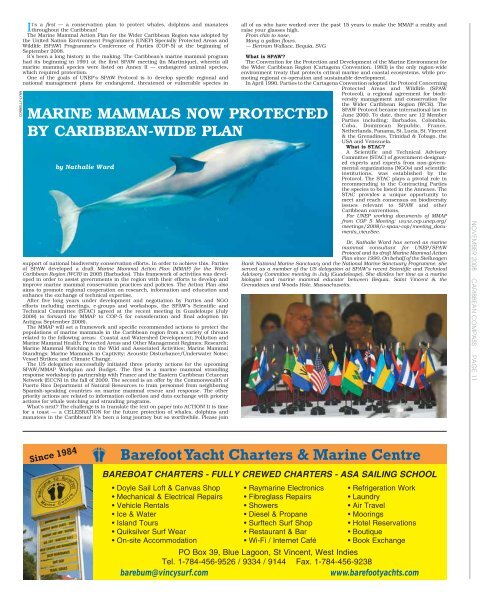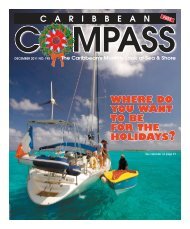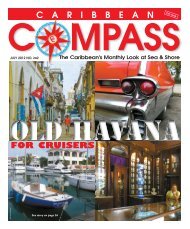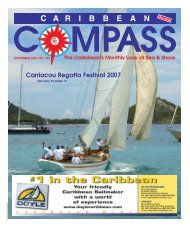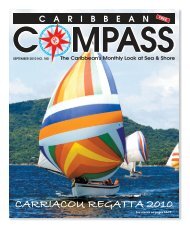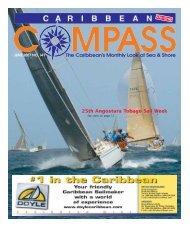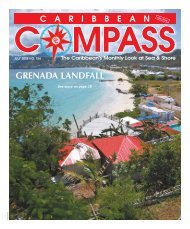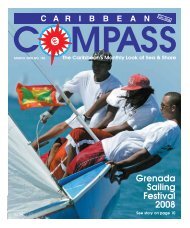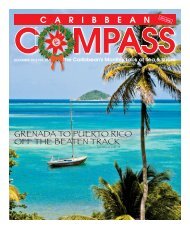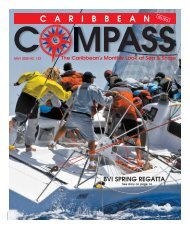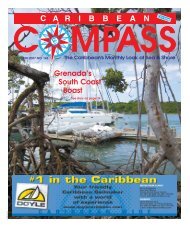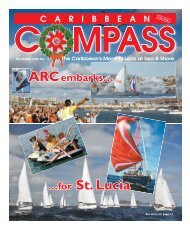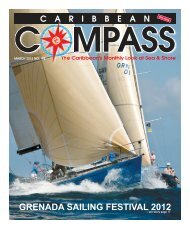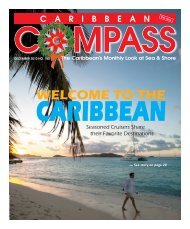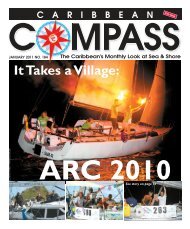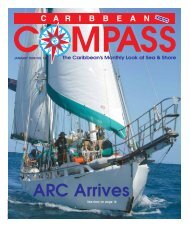A CRUISER'S VIEW OF BEQUIA - Caribbean Compass
A CRUISER'S VIEW OF BEQUIA - Caribbean Compass
A CRUISER'S VIEW OF BEQUIA - Caribbean Compass
You also want an ePaper? Increase the reach of your titles
YUMPU automatically turns print PDFs into web optimized ePapers that Google loves.
CONNELLY-LYNN<br />
t’s a first — a conservation plan to protect whales, dolphins and manatees<br />
Ithroughout the <strong>Caribbean</strong>!<br />
The Marine Mammal Action Plan for the Wider <strong>Caribbean</strong> Region was adopted by<br />
the United Nation Environment Programme’s (UNEP) Specially Protected Areas and<br />
Wildlife (SPAW) Programme’s Conference of Parties (COP-5) at the beginning of<br />
September 2008.<br />
It’s been a long history in the making. The <strong>Caribbean</strong>’s marine mammal program<br />
had its beginning in 1991 at the first SPAW meeting (in Martinique), wherein all<br />
marine mammal species were listed on Annex II — endangered animal species,<br />
which required protection.<br />
One of the goals of UNEP’s SPAW Protocol is to develop specific regional and<br />
national management plans for endangered, threatened or vulnerable species in<br />
MARINE MAMMALS NOW PROTECTED<br />
BY CARIBBEAN-WIDE PLAN<br />
Since 1984<br />
by Nathalie Ward<br />
support of national biodiversity conservation efforts. In order to achieve this, Parties<br />
of SPAW developed a draft Marine Mammal Action Plan (MMAP) for the Wider<br />
<strong>Caribbean</strong> Region (WCR) in 2005 (Barbados). This framework of activities was developed<br />
in order to assist governments in the region with their efforts to develop and<br />
improve marine mammal conservation practices and policies. The Action Plan also<br />
aims to promote regional cooperation on research, information and education and<br />
enhance the exchange of technical expertise.<br />
After five long years under development and negotiation by Parties and NGO<br />
efforts including meetings, e-groups and workshops, the SPAW’s Scientific and<br />
Technical Committee (STAC) agreed at the recent meeting in Guadeloupe (July<br />
2008) to forward the MMAP to COP-5 for consideration and final adoption (in<br />
Antigua September 2008).<br />
The MMAP will set a framework and specific recommended actions to protect the<br />
populations of marine mammals in the <strong>Caribbean</strong> region from a variety of threats<br />
related to the following areas: Coastal and Watershed Development; Pollution and<br />
Marine Mammal Health; Protected Areas and Other Management Regimes; Research;<br />
Marine Mammal Watching in the Wild and Associated Activities; Marine Mammal<br />
Standings; Marine Mammals in Captivity; Acoustic Disturbance/Underwater Noise;<br />
Vessel Strikes; and Climate Change.<br />
The US delegation successfully initiated three priority actions for the upcoming<br />
SPAW/MMAP Workplan and Budget. The first is a marine mammal stranding<br />
response workshop in partnership with France and the Eastern <strong>Caribbean</strong> Cetacean<br />
Network (ECCN) in the fall of 2009. The second is an offer by the Commonwealth of<br />
Puerto Rico Department of Natural Resources to train personnel from neighboring<br />
Spanish-speaking countries on marine mammal rescue and response. The other<br />
priority actions are related to information collection and data exchange with priority<br />
actions for whale watching and stranding programs.<br />
What’s next? The challenge is to translate the text on paper into ACTION! It is time<br />
for a toast — a CELEBRATION for the future protection of whales, dolphins and<br />
manatees in the <strong>Caribbean</strong>! It’s been a long journey but so worthwhile. Please join<br />
all of us who have worked over the past 15 years to make the MMAP a reality and<br />
raise your glasses high.<br />
From chin to nose,<br />
Many a gallon flows.<br />
— Bertram Wallace, Bequia, SVG<br />
What is SPAW?<br />
The Convention for the Protection and Development of the Marine Environment for<br />
the Wider <strong>Caribbean</strong> Region (Cartagena Convention, 1983) is the only region-wide<br />
environment treaty that protects critical marine and coastal ecosystems, while promoting<br />
regional co-operation and sustainable development.<br />
In April 1990, Parties to the Cartagena Convention adopted the Protocol Concerning<br />
Protected Areas and Wildlife (SPAW<br />
Protocol), a regional agreement for biodiversity<br />
management and conservation for<br />
the Wider <strong>Caribbean</strong> Region (WCR). The<br />
SPAW Protocol became international law in<br />
June 2000. To date, there are 12 Member<br />
Parties including: Barbados, Colombia,<br />
Cuba, Dominican Republic, France,<br />
Netherlands, Panama, St. Lucia, St. Vincent<br />
& the Grenadines, Trinidad & Tobago, the<br />
USA and Venezuela.<br />
What is STAC?<br />
A Scientific and Technical Advisory<br />
Committee (STAC) of government-designated<br />
experts and experts from non-governmental<br />
organizations (NGOs) and scientific<br />
institutions, was established by the<br />
Protocol. The STAC plays a pivotal role in<br />
recommending to the Contracting Parties<br />
the species to be listed in the Annexes. The<br />
STAC provides a unique opportunity to<br />
meet and reach consensus on biodiversity<br />
issues relevant to SPAW and other<br />
<strong>Caribbean</strong> conventions.<br />
For UNEP working documents of MMAP<br />
from COP 5 Meeting: www.cep.unep.org/<br />
meetings/2008/v-spaw-cop/meeting_documents_viewSee.<br />
Dr. Nathalie Ward has served as marine<br />
mammal consultant for UNEP/SPAW<br />
Protocol and its draft Marine Mammal Action<br />
Plan since 1990. On behalf of the Stellwagen<br />
Bank National Marine Sanctuary and the National Marine Sanctuary Programme, she<br />
served as a member of the US delegation at SPAW’s recent Scientific and Technical<br />
Advisory Committee meeting in July (Guadeloupe). She divides her time as a marine<br />
biologist and marine mammal educator between Bequia, Saint Vincent & the<br />
Grenadines and Woods Hole, Massachusetts.<br />
Barefoot Yacht Charters & Marine Centre<br />
BAREBOAT CHARTERS - FULLY CREWED CHARTERS - ASA SAILING SCHOOL<br />
• Doyle Sail Loft & Canvas Shop • Raymarine Electronics • Refrigeration Work<br />
• Mechanical & Electrical Repairs • Fibreglass Repairs • Laundry<br />
• Vehicle Rentals • Showers • Air Travel<br />
• Ice & Water • Diesel & Propane • Moorings<br />
• Island Tours • Surftech Surf Shop • Hotel Reservations<br />
• Quiksilver Surf Wear • Restaurant & Bar • Boutique<br />
• On-site Accommodation • Wi-Fi / Internet Café • Book Exchange<br />
PO Box 39, Blue Lagoon, St Vincent, West Indies<br />
Tel. 1-784-456-9526 / 9334 / 9144 Fax. 1-784-456-9238<br />
barebum@vincysurf.com www.barefootyachts.com<br />
NOVEMBER 2008 CARIBBEAN COMPASS PAGE 11


